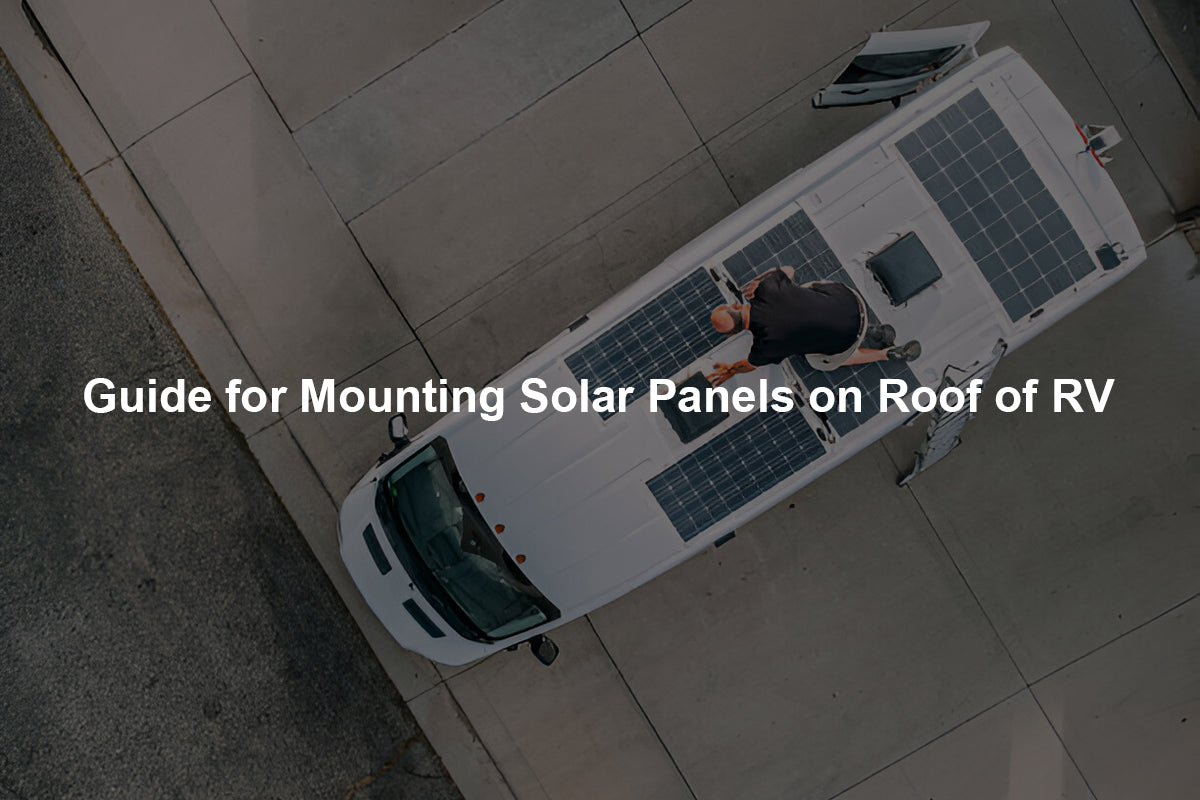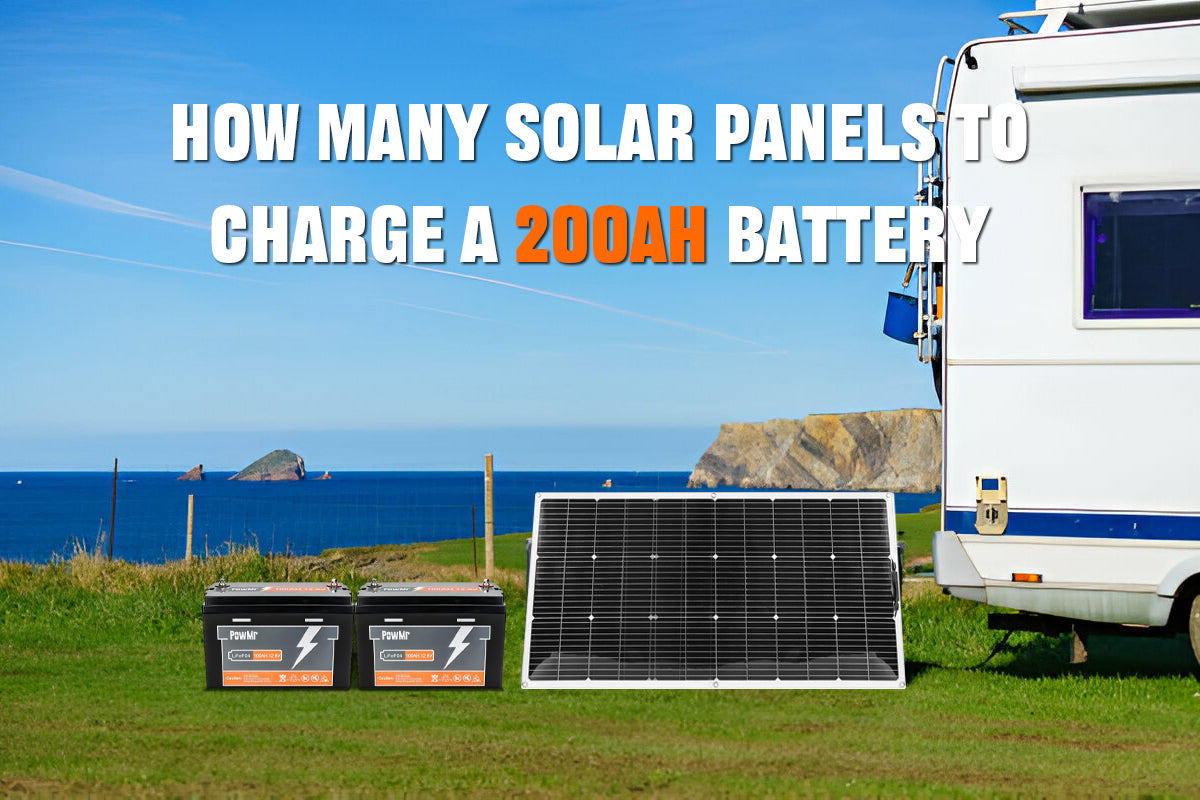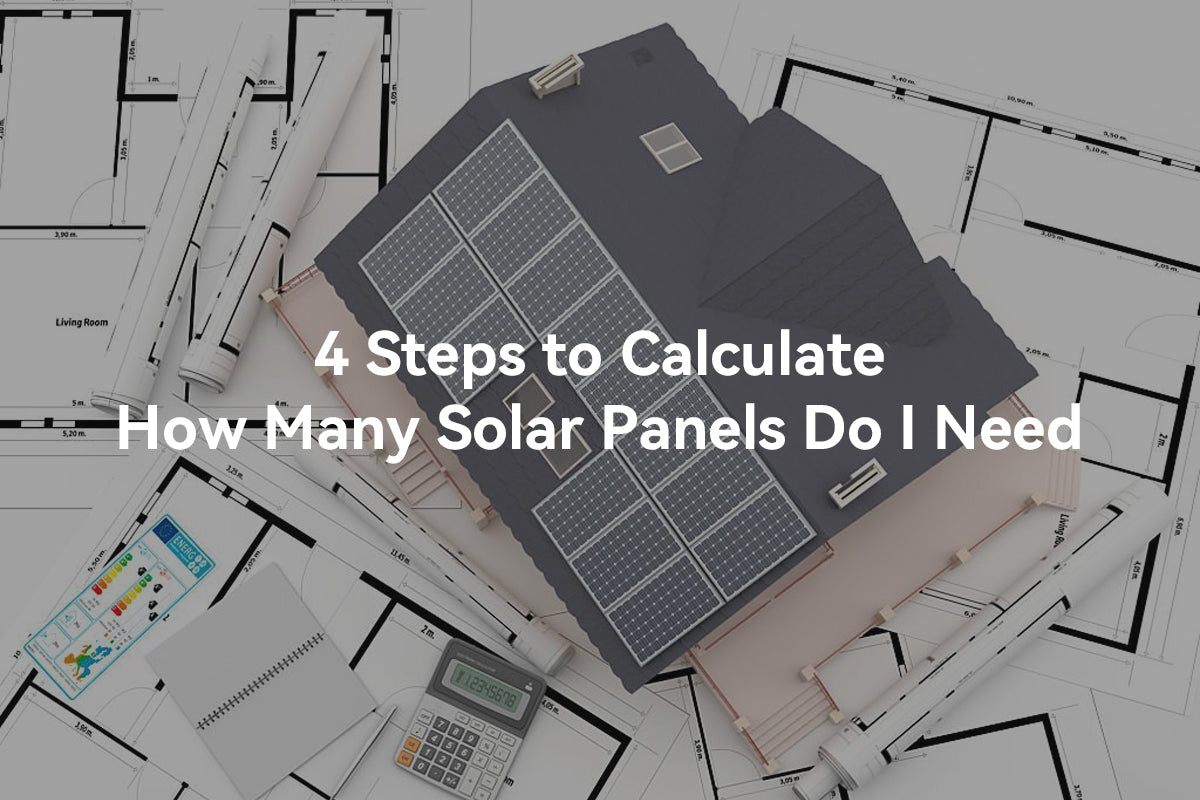การติดตั้งแผงโซลาร์เซลล์บนหลังคา RV ของคุณสามารถปรับปรุงการผจญภัยนอกกริดของคุณได้อย่างมาก โดยนำเสนอทางออกพลังงานที่ยั่งยืนไม่ว่าคุณจะเดินทางไปที่ไหน
อย่างไรก็ตาม เนื่องจากปัจจัยต่าง ๆ เช่น การสัมผัสกับแสงแดด ความโค้งของหลังคา RV และความสามารถในการรับน้ำหนัก จึงเป็นสิ่งสำคัญที่จะต้องพิจารณาสภาพแวดล้อมที่แตกต่างกัน
ในคู่มือที่ละเอียดนี้ เราจะสำรวจ วิธีการที่หลากหลาย สำหรับการติดตั้งแผงโซลาร์เซลล์บนหลังคา RV โดยมี คำแนะนำทีละขั้นตอน ที่ชัดเจนสำหรับการติดตั้งที่ราบรื่น.
ระบบ RV แบบออฟกริดทำงานอย่างไร?
การติดตั้งแบบออฟกริดมอบอิสระในการให้แสงสว่างแก่พื้นที่ของคุณ การเก็บรักษาอาหาร และการจ่ายพลังงานให้กับอุปกรณ์ต่างๆ โดยไม่ต้องพึ่งพาแหล่งพลังงานไฟฟ้าทั่วไปหรือพลังงานจากชายฝั่ง
ต่างจากระบบที่เชื่อมต่อกับกริด ระบบพลังงานหมุนเวียนแบบออฟกริดทำงานอย่างอิสระจากบริการสาธารณูปโภคในท้องถิ่น ระบบพลังงานแสงอาทิตย์โดดเด่นในฐานะโซลูชันพลังงานออฟกริดที่ต้องการและเข้ากันได้มากที่สุดสำหรับ RV ระบบพลังงานแสงอาทิตย์ออฟกริดสำหรับ RV โดยทั่วไปประกอบด้วย:
บทความนี้มุ่งเน้นไปที่การติดตั้งแผงโซลาร์เซลล์บนหลังคา RV โดยไม่ลงลึกในเรื่องการเลือกส่วนประกอบ อย่างไรก็ตาม ที่นี่เรามี แนวทางในการออกแบบระบบพลังงานแสงอาทิตย์:
- วิธีการเลือกอินเวอร์เตอร์ที่ดีที่สุดสำหรับระบบพลังงานแสงอาทิตย์แบบออฟกริด
- คู่มือการเลือกตัวควบคุมการชาร์จพลังงานแสงอาทิตย์ - ประเภทและขนาด
- แบตเตอรี่สำหรับระบบพลังงานแสงอาทิตย์ของฉันมีจำนวนเท่าไหร่
นอกจากนี้เราขอแนะนำ PowMr 30amp MPPT charge controller สำหรับการตั้งค่าที่มีแบตเตอรี่คู่ มันมีความสามารถในการ ชาร์จพลังงานแสงอาทิตย์ และจัดการ การชาร์จระหว่างแบตเตอรี่สตาร์ทและแบตเตอรี่บริการ โดยใช้การตรวจจับ BVS (Battery Voltage System) ปรับแต่งลำดับความสำคัญในการชาร์จได้อย่างง่ายดายโดยการปรับเกณฑ์แรงดันไฟฟ้าตามที่คุณต้องการ.
วิธีที่ดีที่สุดในการติดตั้งแผงโซลาร์เซลล์บนรถบ้านคืออะไร?
เมื่อพูดถึงการติดตั้งแผงโซลาร์เซลล์บน RV มีตัวเลือกหลายอย่างที่ต้องพิจารณา รวมถึง การติดตั้งแบบคงที่, แบบยืดหยุ่น, และแบบเอียง วิธีการแต่ละแบบมีข้อดีและข้อพิจารณาของตัวเอง ขึ้นอยู่กับ รูปทรงหลังคา ของ RV ของคุณและสภาพแวดล้อมการผจญภัยนอกกริดที่คุณมักจะไป.
การติดตั้งแบบคงที่
ออกแบบมาเพื่อความทนทาน ระบบการติดตั้งแบบถาวรถูกออกแบบมาสำหรับ แผงโซลาร์เซลล์แข็ง ต้องมีการเจาะรูบนหลังคา RV จากนั้นติดตั้งขาเกาะเพื่อยึดแผงให้แน่นในตำแหน่งราบบนระบบการติดตั้งแบบถาวร.
การติดตั้งแบบยืดหยุ่น
ปรับให้เข้ากับ รูปร่างของหลังคา RV แผงโซลาร์เซลล์ที่ยืดหยุ่น เช่น แผงฟิล์มบาง ทำให้การติดตั้งง่ายขึ้น แผงเหล่านี้ติดตั้งด้วยเทปกาวเพื่อให้ได้ตำแหน่งที่ต้องการ ลดความจำเป็นในการเจาะรู อย่างไรก็ตาม อาจยังจำเป็นต้องมีรูเดียวเพื่อใช้ในการนำสายไฟเข้าสู่ RV.
หาก RV หรือรถตู้ของคุณมีหลังคาโค้ง PowMr แผงโซลาร์เซลล์แบบยืดหยุ่น ที่สามารถ โค้งงอได้ถึง 258 องศา เป็นตัวเลือกที่ดีที่สุดในการปรับให้เข้ากับรูปทรงที่เป็นเอกลักษณ์ของมัน.
การติดตั้งแบบเอียง
การติดตั้งแบบเอียงนั้นเกี่ยวข้องกับการติดตั้งแผงโซลาร์เซลล์ในมุมที่เอียง โดยเริ่มจากการติดตั้งในแนวนอน ซึ่งจะทำได้ผ่านแพลตฟอร์มที่เอียง ช่วยให้ ปรับมุมของแผง เพื่อให้ได้รับแสงแดดอย่างเหมาะสม การเพิ่มการดูดซับแสงนี้ทำให้วิธีการติดตั้งนี้เพิ่มผลผลิตพลังงานขึ้น
วิธีติดตั้งแผงโซลาร์เซลล์บนหลังคา RV
สำหรับคำแนะนำการติดตั้งอย่างละเอียด โปรดดำเนินการตามคำแนะนำทีละขั้นตอนต่อไปนี้
ขั้นตอนที่ 1 - วัดขนาดหลังคาและวางแผนการจัดเรียงแผงโซลาร์เซลล์
ก่อนติดตั้ง, การวางแผนรูปแบบ จะช่วยให้คุณจินตนาการถึงการวางตำแหน่งของพวกเขาและระบุว่าควรวางเสาโครงสนับสนุนไว้ที่ไหน เมื่อเชื่อมต่อแผงหลายแผง, ให้แน่ใจว่า รักษาระยะห่าง ประมาณ 20 มม. ระหว่างพวกเขา.
จัดเรียงแผงโซลาร์เซลล์ของคุณบนหลังคา RV และใช้เทปสีเพื่อ ระบุตำแหน่งของพวกเขา หลีกเลี่ยงจุดที่อาจมีเงาจากจานดาวเทียมหรือเครื่องปรับอากาศตกลงมา.
นอกจากการเว้นระยะห่างระหว่างแผ่นเพื่อการระบายความร้อนแล้ว ให้พิจารณา ขนาดของขาตั้งที่ติดตั้งถาวร ที่จำเป็นสำหรับการติดตั้งเพื่อให้แน่ใจว่ามีพื้นที่ติดตั้งเพียงพอ.
ขั้นตอนที่ 2 - การกำจัดอุปสรรค
พิจารณาการถอดอุปสรรคใด ๆ ออกจากรถบ้านของคุณ เช่น เสาอากาศทีวีหรือจานดาวเทียม การติดตั้งบนหลังคาจะช่วยให้แผงโซลาร์เซลล์ของคุณได้รับแสงแดดสูงสุดโดยไม่มีอุปสรรค.
ผู้ที่ทำงาน DIY หลายคนมีรถที่มีแร็คหลังคา พวกเขาสามารถติดตั้งแผงแข็งเข้ากับแร็คที่มีอยู่แล้วหรือปรับแต่งแร็คสำหรับแผงได้ การสร้างแร็คที่กำหนดตำแหน่งสกรูไว้ล่วงหน้าเป็นสิ่งที่ดีที่สุด หากไม่สามารถติดตั้งได้ ให้ถอดแร็คออก
ขั้นตอนที่ 3 - ทำความสะอาดและปิดผนึกความสมบูรณ์ของหลังคา
โปรดตรวจสอบรอยฉีก, รู, รอยตัด, และจุดนุ่มในวัสดุหลังคา EPDM (ยาง) โดยซ่อมแซมพื้นที่ที่เสียหาย การจัดการกับปัญหาเหล่านี้จะกลายเป็นเรื่องท้าทายเมื่อแผงถูกติดตั้งแล้ว ให้ถอดส่วนที่เสียหายออก อย่างตั้งใจและเปลี่ยนด้วยวัสดุที่มีคุณภาพใกล้เคียง อย่างไรก็ตาม ควรหลีกเลี่ยงการใช้วัสดุฉนวนเว้นแต่จะมีพื้นที่เพียงพอสำหรับการระบายความร้อนระหว่างแผงโซลาร์เซลล์และหลังคา.
ขั้นตอนที่ 4 - ติดตั้งแผงโซลาร์เซลล์
การติดตั้งแผงโซลาร์เซลล์บนหลังคา RV ของคุณต้องพิจารณาอย่างรอบคอบเกี่ยวกับประเภทของแผงและวิธีการติดตั้ง ไม่ว่าคุณจะใช้แผงแบบยืดหยุ่นหรือแบบแข็ง แต่ละตัวเลือกมีความท้าทายและวิธีแก้ไขของตัวเอง นี่คือคู่มือที่ครอบคลุมเกี่ยวกับสามวิธีการติดตั้งหลัก:
ตัวเลือก 1. ติดตั้งแผงโซลาร์เซลล์แบบยืดหยุ่นบนหลังคา RV
แผงโซลาร์เซลล์แบบยืดหยุ่นให้ผลผลิตเทียบเท่ากับแผงแข็ง แต่มีน้ำหนักเบากว่าและปรับตัวได้ดีกับรูปทรงต่างๆ แม้จะติดตั้งบนหลังคา RV โดยไม่ต้องเจาะ อย่างไรก็ตาม การติดตั้งด้วยกาวมีความเสี่ยง แผงจะดูดซับความร้อนเกินกว่าการผลิตฟอทอน ซึ่งต้องการการระบายความร้อน การติดตั้งโดยตรงบนพื้นผิวที่มีฉนวน เช่น หลังคา RV มีความเสี่ยงต่อการเกิดความร้อนเกินและความเสียหาย.
นี่คือ วิธีแก้ปัญหาง่ายๆ: ใช้ เทปเวลโครเกรดอุตสาหกรรม รอบขอบและด้านหลังของแผงเพื่อให้มีพื้นที่สำหรับการระบายความร้อนในขณะที่ยึดติดกับพื้นผิวหลังคาของคุณ.
นอกจากนี้ บางคนเลือกที่จะฉนวนแผงโซลาร์เซลล์แบบยืดหยุ่นจากหลังคา RV โดย วางแผ่นพลาสติกลูกฟูกไว้ด้านล่าง และใช้เทปอุตสาหกรรม VHB สำหรับการติดตั้ง.
ตัวเลือก 2. ติดตั้งแผงโซลาร์เซลล์แบบแข็งบนหลังคาของ RV
กระบวนการติดตั้งจะแตกต่างกันไปขึ้นอยู่กับประเภทของแผงที่คุณมี แผงแข็งต้องการการยึดด้วยสกรู ซึ่งต้องมีการเจาะรูลงบนหลังคา แผงเหล่านี้สามารถติดตั้งได้ทั้งแบบราบหรือเอียงบนพื้นผิวหลังคา แต่ขาเหล็กที่ใช้ในการติดตั้งจะแตกต่างกัน
ก่อนติดตั้งแผง ควร หาตะแกรงขวางใต้แผ่นไม้อัดหลังคา RV ให้ได้ก่อน ยึดสกรูสำหรับการยึดเข้ากับตะแกรงขวางเหล่านี้แทนที่จะเจาะเข้าไปในไม้อัดบางๆ ใต้หลังคายาง เพื่อให้มั่นใจว่า มีความแข็งแรงเพียงพอ ในการยึดแผงให้มั่นคงในลมแรง.
วิธีการค้นหาแถบขวางหลังคาใต้หลังคา RV
A. เครื่องตรวจจับไม้ - นี่คือวิธีที่ง่ายที่สุดและเชื่อถือได้มากที่สุด วางเครื่องตรวจจับไม้บนหลังคา และมันจะส่งสัญญาณบ่งชี้ตำแหน่งของคานขวางหลังคา.
B. วิธีการเคาะ - เคาะหลังคาเบา ๆ ด้วยปลายด้ามของไขควงขนาดใหญ่และฟังเสียง เสียงที่แน่นบ่งบอกถึงการมีอยู่ของคานข้ามหลังคา ในขณะที่เสียงที่กลวงบ่งบอกถึงพื้นที่ที่ไม่มีคานข้ามหลังคา.
ค. เพดานเปิด - หากเป็นไปได้ การเปิดเพดานสามารถให้การเข้าถึงข้ามคานหลังคาโดยตรงได้ โดยการเปิดการสนับสนุนช่องระบายอากาศหรือทางเข้าที่เพดานอื่น ๆ คุณสามารถเข้าถึง "ห้องใต้หลังคา" ซึ่งคุณสามารถเห็นตำแหน่งของข้ามคานหลังคาได้ ด้วยทางเข้าห้องใต้หลังคา คุณสามารถใช้สายวัดเพื่อวัดตำแหน่งของข้ามคานหลังคาถัดไปได้.
โดยปกติแล้ว วิธีการติดตั้งนี้จะเกี่ยวข้องกับการใช้ Z brackets คุณสามารถเลือกติดตั้งปลายที่มีสองรูลงบนกรอบแผง ซึ่งจะช่วยให้มีความยืดหยุ่นในการวางสกรูหลังคาในตำแหน่งใดก็ได้บนขาเพื่อให้สามารถเจาะเข้าที่คานได้อย่างแม่นยำ.
ถัดไป ให้ติดตั้งขาเหล็กอย่างแน่นหนาให้ตรงกับตำแหน่งของแผง ปิดผนึกขาเหล็กและสกรู ด้วยสารปิดผนึก Dicor เพื่อสร้างการปิดผนึกที่แน่นหนา ป้องกันการรั่วซึมของหลังคาที่อาจเกิดขึ้น อย่าลืมเตรียมผ้าเช็ดมือไว้สำหรับทำความสะอาด จากนั้น ให้ติดตั้งแผงโซลาร์เซลล์ลงบนอุปกรณ์ที่ติดตั้งแล้ว.
ตัวเลือก 3. ติดตั้งแผงโซลาร์เซลล์แบบแข็งเอียงบนหลังคา RV
การติดตั้งแผงโซลาร์เซลล์บนหลังคา RV โดยการเอียง จะช่วยให้คุณสามารถเก็บแผงให้เรียบขณะขับขี่ หรือเอียงไปในทิศทางหนึ่งเมื่อจอดรถ การเพิ่มการสัมผัสกับแสงอาทิตย์โดยการจัดตำแหน่งแผงให้เอียงไปทางทิศใต้เมื่อรถจอดในตำแหน่งที่เหมาะสมสามารถเพิ่มการรับพลังงานจากแสงอาทิตย์ได้อย่างมีนัยสำคัญ อย่างไรก็ตาม ในระหว่างการเดินทาง การเก็บแผงให้ ใกล้กับ หลังคาสามารถ ลดความเสี่ยงของ ความเสียหายจากกิ่งไม้ที่ยื่นออกมาได้
คล้ายกับการติดตั้งแบบถาวร เมื่อคุณหาตำแหน่ง คานขวาง ได้แล้ว คุณสามารถยึดขาและแผงโซลาร์เซลล์เข้ากับหลังคา RV ได้ ความแตกต่างเพียงอย่างเดียวคือในครั้งนี้ คุณจะต้องใช้ ขาตั้งแบบเอียง สุดท้าย อย่าลืมปิดผนึกขาและสกรูของขาโดยใช้สารปิดผนึก Dicor.
เคล็ดลับ
เมื่อทำการติดตั้งอุปกรณ์ยึดหรือการเชื่อมต่อสายเคเบิล ให้หลีกเลี่ยงการขันสกรูหรือโบลต์แน่นเกินไป เนื่องจากอาจทำให้หลังคาหรือส่วนประกอบเสียหายได้ ใช้สเปคแรงบิดที่ผู้ผลิตแนะนำเพื่อป้องกันการบีบอัดซีลเกินไปหรือการทำให้เกลียวหลุด.
ขั้นตอนที่ 5 - เชื่อมต่อแผงโซลาร์เซลล์
เมื่อแผงถูกติดตั้งอย่างมั่นคงแล้ว ก็ถึงเวลาที่จะเชื่อมต่อพวกมัน ขึ้นอยู่กับการตั้งค่าและการกำหนดค่าที่คุณต้องการ คุณสามารถเชื่อมต่อแผงในแบบอนุกรม ขนาน หรือการรวมกันของทั้งสองแบบ (อนุกรม-ขนาน) อ่านบล็อกของเราเกี่ยวกับ การเชื่อมต่อแผงโซลาร์เซลล์แบบอนุกรมและขนาน เพื่อให้แน่ใจว่าการเดินสายไฟและการฉนวนที่ถูกต้องเพื่อป้องกันอันตราย.
ขั้นตอนที่ 6 - ติดตั้งขั้วต่อสายเคเบิล
ในการรันสายเคเบิลผ่านหลังคา RV ของคุณและเข้าสู่ผนัง การเจาะรูมักจะเป็นสิ่งจำเป็น ใช้ อุปกรณ์ป้องกันการเข้าของสายเคเบิล—อุปกรณ์ที่ปิดผนึกและยึดสายเคเบิลขณะที่มันผ่านพื้นผิวเช่นหลังคา RV มันช่วยป้องกันน้ำ ฝุ่น และสารปนเปื้อนจากการเข้ามาใน RV ในขณะที่ยังคงรูปลักษณ์ที่เรียบร้อย เลือกขนาดของอุปกรณ์ที่ตรงกับเส้นผ่านศูนย์กลางของสายเคเบิลของคุณและปฏิบัติตามคำแนะนำการติดตั้งเพื่อให้แน่ใจว่ามีการปิดผนึกกันน้ำ
เคล็ดลับ
หาก RV ของคุณมี "พอร์ตที่เตรียมไว้สำหรับพลังงานแสงอาทิตย์" บนหลังคา คุณอาจไม่ต้องการขั้วต่อสายเคเบิล อย่างไรก็ตาม โปรดทราบว่าปลั๊กของมันอาจมีการปรับเปลี่ยนขั้วไฟฟ้าโดยเจตนาเพื่อรองรับเฉพาะแบรนด์ของแผงพลังงานแสงอาทิตย์ที่เฉพาะเจาะจงเท่านั้น เพื่อยืนยันเรื่องนี้ ให้ใช้โวลต์มิเตอร์หรือมัลติมิเตอร์เพื่อตรวจสอบขั้วของปลั๊ก หากจำเป็น ให้พิจารณาซื้อ ปลั๊ก SAE แบบกลับขั้ว.
ขั้นตอนที่ 7 - ดึงสายเคเบิลผ่านจุก
ให้แน่ใจว่าคุณ
เคล็ดลับ
อย่าลืม เชื่อมต่อแบตเตอรี่ กับตัวควบคุมการชาร์จพลังงานแสงอาทิตย์ ก่อน เพื่อป้องกันความเสียหายก่อนที่จะเชื่อมต่อแผงโซลาร์เซลล์ กรุณาเสร็จสิ้นการติดตั้งระบบพลังงานแสงอาทิตย์ตามที่กำหนด.
นี่คือคู่มือที่ครอบคลุมสำหรับการติดตั้งแผงโซลาร์เซลล์บนหลังคา RV ของคุณ มันรวบรวมข้อมูลเชิงปฏิบัติจากเจ้าของ RV ที่มีประสบการณ์เพื่อทำให้การเข้าถึงวิธีการติดตั้งที่มีประสิทธิภาพเป็นไปได้ง่ายขึ้น ก่อนที่จะเริ่มโครงการใด ๆ หรือทำการซื้อที่สำคัญ เราขอแนะนำให้ทำการวิจัยอย่างละเอียดและปรึกษากับผู้เชี่ยวชาญ เราขอปฏิเสธความรับผิดชอบต่อความเสียหายที่เกิดขึ้นกับ RV ของคุณหรือการบาดเจ็บที่เกิดจากการใช้เคล็ดลับ คำแนะนำ หรือคำสั่งของเรา.



